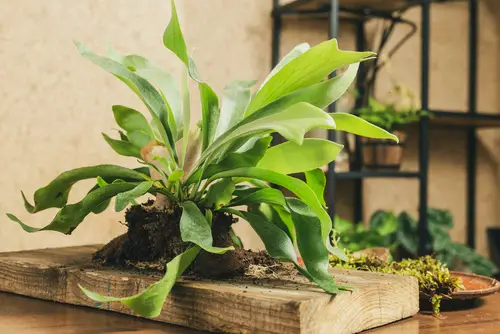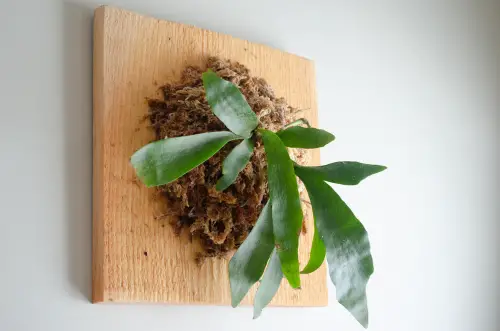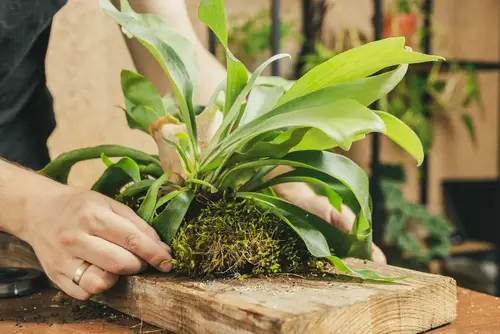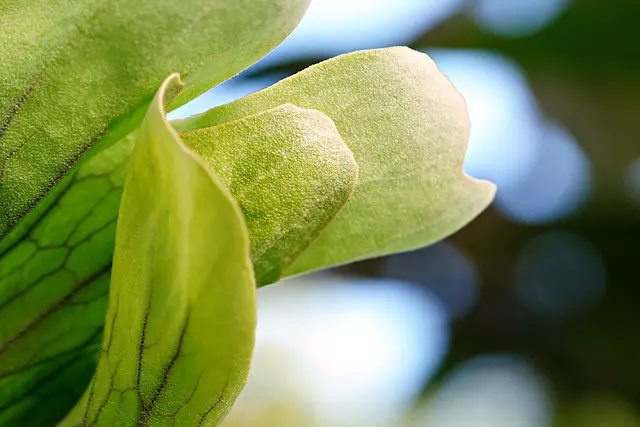Staghorn ferns are a popular choice for indoor and outdoor gardeners alike. They are known for their unique appearance, which resembles the antlers of a stag.
However, one common problem that staghorn fern owners face is brown leaves.Staghorn Fern Leaves Turning Brown can be a sign of a variety of issues, including overwatering, underwatering, low humidity, and root rot.
Understanding the causes of browning in staghorn fern leaves is crucial for treating the issue. Overwatering is a common cause of brown leaves, as it can lead to root rot.
Additionally, underwatering and low humidity can cause leaves to dry out and turn brown. Identifying and treating root rot is also important, as it can quickly spread and kill the entire plant. Proper care for staghorn ferns, including pruning and fertilizing, can also help prevent brown leaves.
Key Takeaways
- Brown leaves on staghorn ferns can be caused by overwatering, underwatering, low humidity, and root rot.
- Identifying and treating root rot is crucial for preventing the spread of the issue.
- Proper care, including pruning and fertilizing, can help prevent brown leaves.
More posts on this category:
Understanding Staghorn Ferns

Staghorn ferns (Platycerium bifurcatum) are epiphytic plants native to Asia and Australia. They are known for their unique appearance, with two distinct types of leaves: sterile fronds that are flat and shield-like, and fertile fronds that are branched and resemble antlers.
Staghorn ferns are popular houseplants because of their striking appearance and ease of care. They grow best in bright, indirect light and require minimal watering. Overwatering can be detrimental to their health, causing their leaves to turn brown and wilt.
As staghorn ferns mature, it is normal for their older leaves to turn brown and dry up. This is a natural part of the plant’s life cycle, and it is not a cause for concern. However, if the majority of the plant’s leaves are turning brown, it may be a sign of a problem.
Staghorn ferns are also susceptible to leaf burn if they are exposed to direct sunlight. It is important to place them in a spot with bright, indirect light to avoid this issue.
Staghorn Fern Leaves Turning Brown – 4 Common Problems
Staghorn ferns are fascinating plants that are known for their unique growth patterns and the way they can be mounted on walls or hung in baskets. However, these plants can be quite sensitive, and their leaves may start to turn brown for various reasons.
In this section, we will discuss the most common causes of browning in staghorn fern leaves.
1. Watering Issues
One of the most common reasons why staghorn fern leaves turn brown is due to watering issues. Overwatering or underwatering can cause the leaves to dry out, turn brown, and eventually die.
If the soil is too wet, the roots may start to rot, and the plant will not be able to absorb enough water. On the other hand, if the soil is too dry, the leaves may start to curl up and turn brown.
To avoid overwatering or underwatering, it is important to water the plant according to its needs. Staghorn ferns prefer to be watered once a week during the growing season and once every two weeks during the dormant season. It is also important to mist the leaves regularly to maintain humidity levels.
2. Temperature and Humidity Factors
Staghorn ferns thrive in warm and humid environments, and they can suffer if the temperature or humidity levels are not optimal. Low humidity levels can cause the leaves to dry out and turn brown, while high temperatures can cause the leaves to wilt and turn brown.
To maintain optimal temperature and humidity levels, it is recommended to keep the plant in a room with a temperature between 60 and 75 degrees Fahrenheit and a humidity level between 50 and 80 percent. If the air is too dry, mist the leaves regularly or place a humidifier near the plant.
3. Exposure to Direct Sunlight

Staghorn ferns prefer to be in bright, indirect light, and exposure to direct sunlight can cause the leaves to burn and turn brown. If the plant is exposed to direct sunlight, the leaves may start to develop black spots, which can eventually lead to browning.
To avoid exposure to direct sunlight, it is recommended to keep the plant in a shaded area or to filter the light with a sheer curtain or shade cloth.
4. Pest Infestations
Staghorn ferns can be susceptible to pest infestations, such as mealybugs and scale. These pests can cause the leaves to turn brown and develop black spots. If the infestation is severe, the plant may eventually die.
To prevent pest infestations, it is important to inspect the plant regularly and treat any pests immediately. You can use an insecticidal soap or neem oil to get rid of mealybugs and scale.
Identifying and Treating Root Rot
When staghorn ferns are overwatered or planted in poorly-draining soil, they may develop root rot. Root rot is a fungal disease that affects the roots of the plant, causing them to decay and turn brown or black. If left untreated, it can spread to the rest of the plant and cause the leaves to turn brown and wilt.
To identify root rot, gently remove the plant from its pot and examine the roots. Healthy roots should be white or light brown and firm to the touch. If the roots are soft, slimy, and dark brown or black, it is likely that the plant has root rot.
To treat root rot, it is important to remove the affected roots and repot the plant in fresh, well-draining soil. Use a clean pair of scissors or pruning shears to trim away any brown or black roots, making sure to cut back to healthy tissue.
If the entire root ball is affected, it may be necessary to remove the plant from its pot and wash away all of the soil.
Once the roots have been pruned, repot the plant in fresh soil that has been amended with perlite or sand to improve drainage. Make sure the pot has drainage holes to allow excess water to escape. Water the plant sparingly until new growth appears, and avoid fertilizing until the plant has fully recovered.
Preventing root rot is key to keeping staghorn ferns healthy. Make sure to plant them in well-draining soil and water them only when the top inch of soil feels dry to the touch. Avoid letting the plant sit in standing water, and make sure the pot has adequate drainage. With proper care, staghorn ferns can thrive for years to come.
The Role of Fronds in Staghorn Ferns
Staghorn ferns are known for their unique fronds, which come in two types: shield fronds and antler fronds. These fronds play an important role in the health and growth of the plant.
Shield Fronds

Shield fronds are the base of the staghorn fern. They are brown and green and shaped like a shield, hence the name. Shield fronds are responsible for attaching the plant to a tree or other support structure. They also absorb nutrients and water from the air and surrounding environment.
As shield fronds age, they may turn brown and eventually die off. This is a natural part of the plant’s life cycle and does not necessarily indicate a dying staghorn fern. However, if all the shield fronds are turning brown, it may be a sign of overwatering or other issues.
Antler Fronds
Antler fronds are the most recognizable feature of the staghorn fern. They are large, bifurcated leaves that shoot out of the center of the plant, resembling the antlers of a deer or moose. Antler fronds are responsible for photosynthesis, the process by which the plant converts sunlight into energy.
Antler fronds may also turn brown or black as they age. This is normal and does not necessarily indicate a dying staghorn fern. However, if all the antler fronds are turning brown, it may be a sign of underwatering or other issues.
Proper Care for Staghorn Ferns
Staghorn ferns are beautiful and unique plants that require proper care to thrive. One common issue that staghorn fern owners face is the browning of leaves. In this section, we will discuss the proper care practices that can help prevent and treat this problem.
1. Watering Schedule
Staghorn ferns should be watered regularly but not excessively. Overwatering can lead to root rot and other problems. During the summer, staghorn ferns should be watered once a week, while in the winter, they should be watered once every two weeks.
It is important to note that staghorn ferns should not be watered from above, as this can lead to water accumulation in the crown and cause the leaves to rot. Instead, water should be applied directly to the soil or substrate.
2. Temperature and Humidity Control
Staghorn ferns prefer temperatures between 50 and 100°F (10 and 38°C). They also require high humidity levels to thrive. A humidifier can be used to maintain a humidity level of 60-80%. If a humidifier is not available, misting the leaves regularly can also help maintain proper humidity levels.
3. Proper Exposure to Sunlight
Staghorn ferns require bright, indirect sunlight. Direct sunlight can scorch the leaves and cause them to brown. They can be placed near a window that receives bright, indirect sunlight or under a shade cloth.
4. Preventing and Treating Pests
Staghorn ferns can be susceptible to pests such as mealybugs, scale insects, and spider mites. To prevent these pests, it is important to keep the plant clean and free of debris. If pests do appear, they can be treated with insecticides specifically formulated for indoor plants.
Pruning and Fertilizing Staghorn Ferns

Pruning Techniques
When staghorn fern leaves turn brown, it is usually a sign of natural aging. However, if the brown leaves are unsightly or numerous, pruning can be done.
Pruning is best done during the growing season in the summer months. It is important to note that pruning should only be done on healthy leaves and not on leaves that are diseased or damaged.
To prune staghorn ferns, use a sharp pair of pruning shears or scissors. Cut the brown leaves off at the base, being careful not to damage the healthy leaves or the shield frond. The shield frond is the protective layer that covers the roots and should not be removed during pruning.
Fertilizing Methods
Staghorn ferns do not require frequent fertilization, but occasional feeding can help promote growth and health. Fertilizer should only be applied during the growing season from spring to early fall.
A slow-release fertilizer can be used, or a homemade compost can be applied. Soaking the staghorn fern in a diluted fertilizer solution can also be effective. Organic matter, such as compost or well-rotted manure, can be added to the soil to provide nutrients.
When fertilizing staghorn ferns, it is important to follow the manufacturer’s instructions or use a diluted solution to avoid over-fertilizing. Over-fertilizing can cause damage to the roots and leaves.
Conclusion
Brown leaves on a staghorn fern can be a sign of various issues, including overwatering, underwatering, pest infestations, and age. It is essential to identify the cause of the browning to address the problem effectively.
If the browning is due to overwatering, reducing the frequency of watering can help. On the other hand, if the issue is underwatering, increasing the frequency of watering may be necessary. It is crucial to maintain consistent moisture levels without letting the soil become waterlogged.
Pest infestations can also cause browning of staghorn fern leaves. Regular inspections and treatment with appropriate insecticides can help prevent and control infestations.
Lastly, it is normal for the lower shield fronds of a staghorn fern to turn brown and crispy over time. However, if the browning affects the antler fronds or occurs prematurely, it may be a sign of an underlying issue.
Frequently Asked Questions

What are some common problems with staghorn ferns?
Staghorn ferns are generally hardy plants, but they can develop problems if they are not cared for properly. Some common problems include brown or black fronds, which can indicate overwatering or underwatering, and yellowing fronds, which can indicate nutrient deficiencies.
How do I know if I’ve overwatered my staghorn fern?
Overwatering is a common problem with staghorn ferns and can cause the fronds to turn brown or black. To determine if you’ve overwatered your staghorn fern, check the soil for moisture. If the soil is soggy or waterlogged, you’ve likely overwatered the plant.
How do I mount a staghorn fern?
Mounting a staghorn fern is a popular way to display the plant. To mount a staghorn fern, you will need a piece of wood, such as a board or a tree branch, and some sphagnum moss.
First, soak the sphagnum moss in water until it is moist but not dripping. Then, place the moss on the wood and position the staghorn fern on top of the moss. Finally, use wire or string to secure the fern to the wood.
Why are the shield fronds on my staghorn fern turning brown?
It is normal for the lower, small shield fronds on a staghorn fern to turn brown and crispy. This is because these fronds are older and are no longer needed by the plant. However, if the shield fronds are turning brown at the base, it could indicate a problem with the plant’s root system.
What are some tips for caring for staghorn fern roots?
Staghorn ferns are epiphytes, which means they grow on other plants and do not need soil to thrive. To care for staghorn fern roots, it is important to keep them moist but not waterlogged. You can mist the roots with water or soak the plant in a bucket of water for a few minutes every week or two.
What kind of fertilizer should I use for my staghorn fern?
Staghorn ferns do not need a lot of fertilizer, but they can benefit from occasional feeding. Use a balanced, water-soluble fertilizer, such as 20-20-20, and dilute it to half strength. Fertilize the plant once a month during the growing season and once every two months during the winter.

Hey, I’m Lisa and I’ve been an avid gardener for over 30 years. I love writing, talking and living in the garden! Feel free to connect with me on my socials below


